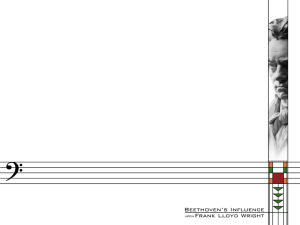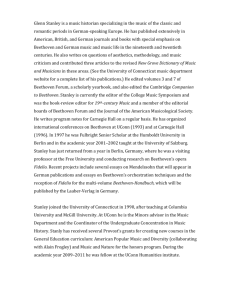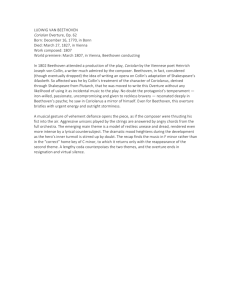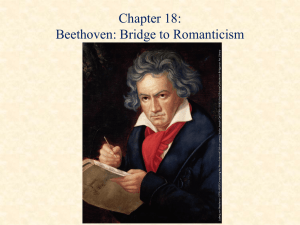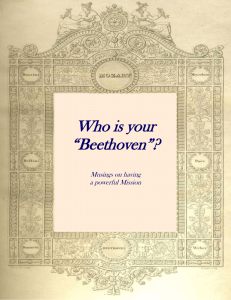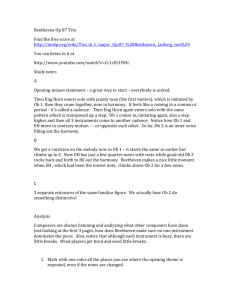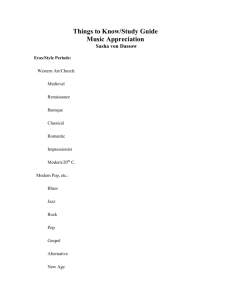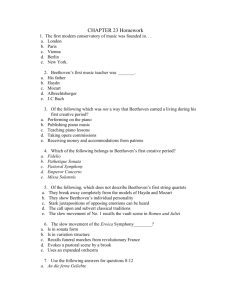Beethoven
advertisement
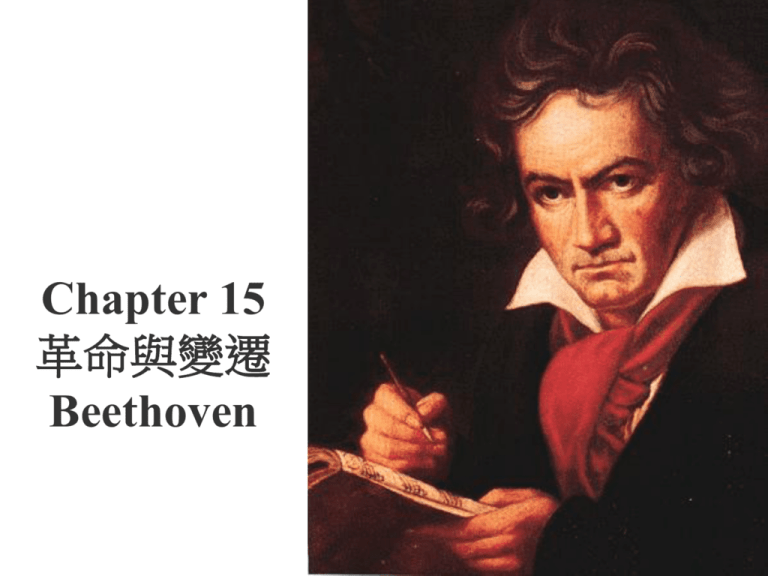
Chapter 15 革命與變遷 Beethoven 時代-法國大革命 1. 第一階段 (1789-92) 尋求改革專制政府 2. 第二階段 (1792-94), 奧國普魯士攻打 法國, 造成極端, 暴民專制, 處決國王貴族 與同情者. 3. 第三階段(1794-99) 較溫和中庸的憲法 產生, 但經濟危艱 Napoleon Bonaparte 拿破崙 (1769 – 1821) Napoleon Bonaparte 1. 2. 3. 4. 5. 6. 7. 戰爭英雄, 1799, Napoleon成為共和第一執政 官. 1804, Napoleon 自立為皇帝. 透過軍事力量, 拓展政治版圖置整個歐洲. Napoleon也進行政治改革使法國政府效率提 高. 1814, 對俄戰爭失敗導致Napoleon潰敗與遜位. 逃亡後, 重新掌權, 戰敗 Waterloo. 雖然失敗, Napoleon 散播了民主與民族主義 的種子到全歐洲. 工業革命 1. 2. 3. 4. 5. 技術改良, 使歐洲經濟從農業社會轉為 工業社會. 革命開始於英國紡織工業. 其他工業跟進, 也包括樂器製造. Men, women, and children worked at factories and coal mines, often in poor working conditions. 中產階級崛起, 貴族沒落, 新貧窮階級更 辛苦. 出生1770-1827 問題家庭: 酗酒的祖母, 酗酒且虐待狂的父 親, 憂鬱的母親 三次藝術生命的重生 1789 1803 1819 貝多芬的三個時期 1802年之前 – 古典 1803-1814 – 英雄時期, 交響曲時期 1818-1826 – 晚期 第一時期(1770-1802) Bonn (1770-1791) 1. He studied music with his father and other local musicians. 2. He entered the service of Maximilian Franz, elector of Cologne. 3. He attracted attention as a virtuoso pianist and improviser (see HWM Source Reading, page 574). 4. Haydn praised Beethoven's music and urged the elector to send him to Vienna. 第一時期(1770-1802) Vienna (1792-1802) 1. He studied with Haydn and took counterpoint lessons with Johann Georg Albrechtsberger. 2. Beethoven established himself as a pianist and composer. 3. He played in public concerts and taught wealthy students. 4. Beethoven earned additional income when he began to publish his compositions. 第一時期(1770-1802) The early pianos sonatas 1. Most of Beethoven's earliest works are for piano. 2. The early sonatas were conceived for amateurs, although the technical demands were increasing. 3. Like Mozart, Beethoven used strong contrasts of style to delineate form and to expand the expressive range. Sonate pathétique, Op. 13 in C Minor, 1799 1. 2. a. b. c. The title suggests suffering and a tragic mode of expression. The sonata has three movements. The passionate first movement begins with a dramatic slow introduction, which returns twice during the movement. The serene middle movement is in A-flat major. The finale returns to the stormy mood and key of the first movement. The third movement The pervasive minor mode conveys the sense of pathos. a. It is in a sonata-rondo form: ABACAB'A Coda. b. The refrain is a simple period. c. The refrain and first episode resemble a sonataform exposition. d. The central episode (C), in A-flat major, is contrapuntal and serves as a development section. e. The return of the B material in the third episode is in the tonic, as it would in a sonata form. f. The refrain theme recalls the second theme of the first movement. Symphony No. 1 , 1800 1. 2. a. b. c. d. e. The work is similar to the late symphonies of Haydn and Mozart. Distinctive features A slow introduction that avoids a clear tonic cadence Dynamic shadings Prominent woodwinds A scherzo-like third movement Lengthy codas for the outer movements 中期 (1803-1814) A. 1. 2. 3. 4. Around 1803, Beethoven began to compose in a new style, due in part to support by patrons and publishers. Several patrons joined together to keep Beethoven in Vienna. The Archduke Rudolph was Beethoven's piano and composition student. Publishers competed for Beethoven's music. Beethoven often dodged deadlines, giving him time to revise his works. 中期 (1803-1814) 1. 2. 3. His output is significantly less than that of Haydn and Mozart. Beethoven jotted down ideas in notebooks (see HWM Figure 23.3). These notebooks allow us to follow the progress of his ideas (see NAWM 109 commentary). 中期 (1803-1814) 1. 2. 3. His output is significantly less than that of Haydn and Mozart. Beethoven jotted down ideas in notebooks (see HWM Figure 23.3). These notebooks allow us to follow the progress of his ideas (see NAWM 109 commentary). 耳聾, 1802 1. 2. He considered suicide, but resolved to work for art, as described in his Heiligenstadt Testament (see HWM Source Reading, page 578). Beethoven appeared less often in public, but kept composing. 耳聾, 1802 1. 2. He considered suicide, but resolved to work for art, as described in his Heiligenstadt Testament (see HWM Source Reading, page 578). Beethoven appeared less often in public, but kept composing. 耳聾 Many of Beethoven's compositions seem to reflect the struggle of his own life. 1. The themes can be seen as characters in a drama. 2. Instrumental music was no longer just an entertainment or diversion. Haydn 與 Mozart模式. The music of the middle period builds on the Traditions can be seen in genres, forms, melodic types, phrasing, and textures. 1. Beethoven expanded the forms to unprecedented lengths. 2. Despite the expansions, Beethoven is economical in his material. Eroica Symphony, No. 3 in E-flat Major (1803-4) 1. The Eroica is longer than any previous symphony. 2. The title suggests that the symphony is a celebration of a hero. 3. Beethoven originally named the symphony "Bonaparte," but reportedly tore up the title page when Napoleon declared himself emperor The first movement 1. a. b. c. can be seen as a story of challenge, struggle, and final victory. The main motive of the first theme serves as the protagonist, is triadic, and has a surprising C-sharp at the end (see HWM Example 23.2a). This motive undergoes numerous transformations during the movement (see HWM Example 23.2b-e). The principal antagonist theme, which also recurs several times, creates a duple meter with accents on weak beats The first movement d. e. f. g. h. The antagonist theme leads to a terrifying dissonant climax in the lengthy development section. Following this climax, a new theme is introduced that is related to the protagonist theme. The resolution of conflict can be seen in the recapitulation (see HWM Example 23.4). The lengthy coda brings back material from the development and reaffirms the resolution. Beethoven's sketches provide valuable information about the conception and structure of his music. Slow movement A funeral march in C minor. a. The march is full of tragedy and pathos. b. A contrasting section in C major contains fanfares and celebratory lyricism. c. The return of the march is varied. d. The movement has links to Revolutionary music in France, including a striking parallel to a march by François-Joseph Gossec rd 3 1. 2. 3. & 4th movements The third movement is a quick scherzo with prominent horn calls in the trio. The finale mixes variations, fugues, development, and marches using a theme from Beethoven's ballet music in The Creatures of Prometheus. With this symphony, Beethoven challenged listeners to engage in music deeply and thoughtfully 英雄時期交響曲 貝多芬海里根遺書 Heiligenstadt Testament 1802年因耳疾痊癒無望, 於海里根寫下 遺書 貝多芬海里根遺書 Beethoven英雄交響曲Op. 53 1. 寫作背景 1802~1803 l 從自殺邊緣走出而以Stoic般的新人生觀面 對: 順其自然, 聽天由命。 l 第二號交響曲未有太大的革新, 是莫札特38 號Prague交響曲或海頓的London Symphonies 成功的承繼者。 革命性的改變,第三號(改變)十九世紀作 曲的方向。 l 與第九號同為Beethoven個人最鍾愛的交響 曲,也十分有趣的有類似的架構,從悲劇超脫 而進入快樂(Joy)。 戲劇與聲樂 a. b. c. 1. 2. 1. Beethoven's only opera, Fidelio, is based on a rescue plot. The opera glorifies heroism and the humanitarian ideas of the Revolution. Leonore, dressed as a man, rescues her husband from prison. Beethoven revised the opera several times. Beethoven composed other dramatic music, including incidental music for the play Egmont, written by Goethe. In Beethoven's Lieder, the music is as interesting as the poetry. 室內樂 1. a. b. c. 1. 2. a. Major works include: Two violin sonatas, including Op. 47 (the Kreutzer) The Archduke Piano Trio Op. 97 Five string quartets Beethoven continued to test the technical abilities of amateurs. The three quartets of Opus 59 were dedicated to the Russian ambassador to Vienna, Count Razumovsky. Beethoven introduced Russian themes into two of the movements. 協奏曲 1. 2. 3. The concertos of the middle period are on a grander scale than earlier works. Beethoven expanded the dimensions and expressive range in the Piano Concerto No. 5 in E-flat Major (the Emperor) and in the Violin Concerto in D Major. The soloist opens the Piano Concerto No. 5 with a cadenza. 協奏曲 1. 2. 3. The concertos of the middle period are on a grander scale than earlier works. Beethoven expanded the dimensions and expressive range in the Piano Concerto No. 5 in E-flat Major (the Emperor) and in the Violin Concerto in D Major. The soloist opens the Piano Concerto No. 5 with a cadenza. 其他的交響曲 1. a. b. c. d. e. f. Symphony No. 5 (1807-8) 由C minor 轉至 C major,象徵掙扎中求勝. 四個音的動機主導整個第一樂章, 此一動機 在四樂章中都出現. 第三樂章 scherzo經由一過門直接進入終曲. The transition begins softly with the timpani playing the motive. The entrance of the full orchestra at the beginning of the final movement includes the trombones on a C-major chord. The finale also adds a piccolo and contrabassoon. 第六號交響曲 a. b. c. d. This work was premiered on the same program as Symphony No. 5. Each of the movements has a title describing life in the country. An extra movement (Storm) precedes the finale. The woodwinds imitate birdcalls in the coda of the second movement. 晚期 A. 1. 2. 3. 4. 5. Beethoven 晚年過著更加與世隔離的生 活. 近乎全聾. 對朋友十分猜忌. Beethoven also suffered from family problems, ill health, and fear of poverty. Vienna 大戰後的蕭條, 較難有大型樂曲 產生, Count Metternich 的高壓統治, 更 雪上加霜. Beethoven abandoned the heroic style. 晚期風格特徵 1. 2. 3. 4. 5. a. b. c. Beethoven晚期四重奏以總譜出版, 有演奏與 研究雙重的功能. 樂曲愈發內省樂匯更加集中. Classical forms維持, 但有更大的改變. Variation structures focused on the substance of a theme. Beethoven emphasized continuity. He blurred divisions between phrases. Successive樂章相連往往無間斷. The songs of An die ferne Geliebte (To the Distant Beloved), which inaugurate the genre of a song cycle, are sung without breaks 晚期風格特徵 1. 2. 3. 4. 5. a. b. c. Beethoven晚期四重奏以總譜出版, 有演奏與 研究雙重的功能. 樂曲愈發內省樂匯更加集中. Classical forms維持, 但有更大的改變. Variation structures focused on the substance of a theme. Beethoven emphasized continuity. He blurred divisions between phrases. Successive樂章相連往往無間斷. The songs of An die ferne Geliebte (To the Distant Beloved), which inaugurate the genre of a song cycle, are sung without breaks 晚期風格特徵 Beethoven 探索更不尋常的音響效果. 2. Beethoven建立了演奏者必須尋覓作者旨意 的傳統. 3. 模仿對位, 複格的使用為此時的特色. a. Fugal 終曲 包括: 1. Piano Sonatas Opp. 106 and 110 2. Symphony No. 9 3. Grosse Fuge (Great Fugue). a. Beethoven 也以 fugue 作第一樂章 Op. 131 4. Beethoven常改變樂章的數目與安排 1. 晚期風格特徵 Beethoven 探索更不尋常的音響效果. 2. Beethoven建立了演奏者必須尋覓作者旨意 的傳統. 3. 模仿對位, 複格的使用為此時的特色. a. Fugal 終曲 包括: 1. Piano Sonatas Opp. 106 and 110 2. Symphony No. 9 3. Grosse Fuge (Great Fugue). a. Beethoven 也以 fugue 作第一樂章 Op. 131 4. Beethoven常改變樂章的數目與安排 1. 四重奏First movement a. b. c. d. e. f. g. h. 使用慢板與複格形式極少用於第一樂章. The 以四音動機開始,ending with a 突強. The exposition has four statements of the theme. The answer form of the theme is on the subdominant. Later statements of the themes are separated by episodes. The final entrances are in C-sharp minor and include augmentation. The movement is extremely emotional and uses unusual harmonies. The key areas include E major, G-sharp minor, B major, A major, and D major, all of which are keys of later movements. 其他晚期作品 1. a. b. c. Missa solemnis 莊嚴彌撒 Originally intended as a mass for the elevation of Archduke Rudolph to archbishop, the work became too long and elaborate for liturgical use. The influence of Handel can be seen in the choral writing, but the five movements are unified into a symphonic structure. The work functions as a concert piece. 其他晚期作品交響曲No. 9 a. b. c. d. e. May 1824 首演. Beethoven did not hear the applause after the scherzo movement. The first three movements, lasting more than an hour, are on a grand scale. The most striking innovation of the symphony is the use of voices in the finale, which uses Schiller's poem Ode to Joy. The final movement follows an unorthodox format. 文化的英雄-Beethoven A. B. C. D. E. His life story defines the Romantic view of the outcast artist. Many of his works were immediately popular and have remained so. His late works are now viewed as achieving greatness. Beethoven's works are central to the performing repertoires of soloists and ensembles. Beethoven greatly influenced later composers. 浪漫主義 A. B. C. D. 個人情感與其表達. 主觀意向而非客觀. 幻想與遠方. 神秘, 大自然, 新感官 浪漫主義哲學背景 A. B. C. D. Immanuel Kant 先驗理想主義 Hegel Schopenhauer Karl Marx 浪漫主義 A. B. C. D. E. 器樂 超技 民族主義 Schopenhauer Karl Marx Conducts
